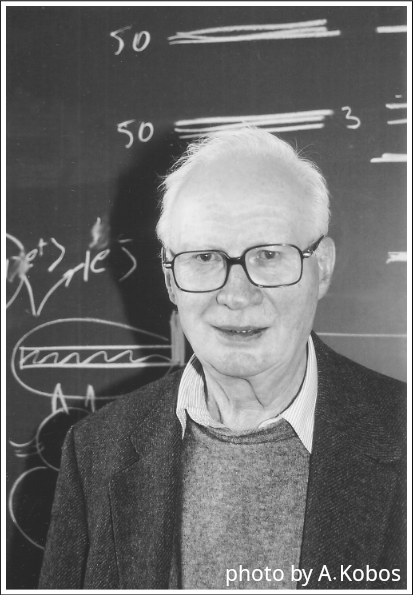Wiesław Czyż (1927 – 2017)

Professor Wiesław Czyż, an outstanding theoretical physicist and former editor-in-chief of Acta Physica Polonica B, passed away on 8 April 2017 after a long illness.
Wiesław Czyż was born on 2 May 1927 in Lublin (eastern Poland). His education was interrupted by the Second World War, during which he was active in the Polish resistance (the Home Army). After the war, he completed his master's degree in mathematics at the Maria Curie-Skłodowska University in Lublin. His career in physics began in 1948, when he moved to Kraków to work at the Institute of Physics of the Jagiellonian University. He received his PhD in 1955 for a dissertation on spin interactions in nuclear matter. Soon after the establishment of the Institute of Nuclear Physics in Kraków, he created its Theory Department, which he headed for 34 years.
During his long research career, Wiesław Czyż was associated with many institutions. He spent two years (1957 – 1959) at the Niels Bohr Institute in Copenhagen, where he developed an interest in theoretical high-energy physics, his life-long scientific passion. At this hot spot of theoretical physics, he met and was involved in physics discussions, as well as the real work leading to publications, with many of his future friends, among them Aage Bohr, Ben Mottelson, Gordon Baym, Torleif Erikson, Sheldon Glashow, Jeffrey Goldstone, Kurt Gottfried and Leo Kadanoff.
Then, in the early 1960s, he visited the Stanford Linear Accelerator Centre, where he met and developed close friendships with James Bjorken and John D. Walecka with whom he worked on the sum rules in electron-nucleus collisions, making significant contributions to our understanding of nuclear structure, and developing theoretical tools that proved essential to the study of the scattering of composite particles. Indeed, in the late 1960s, Czyż completed a series of seminal papers on high-energy scattering of strongly interacting composite particles that established him as a leading expert in the subject, and proved fundamental to the study of hadronic and nuclear collisions. His close collaboration and long-standing friendship with Leonard C. Maximon from George Washington University and the National Bureau of Standards also dates from this period.
In Poland, he kept in touch with the group of theoretical physicists at the Jagiellonian University, especially with Andrzej Białas, with whom he published many common papers, including their most famous one, on the wounded nucleon model, completed in 1976.
Throughout his career Czyż developed close relations with the community of theoretical physicists in the United States, visiting Stanford, Seattle, Stony Brook, Washington D.C., Urbana and Virginia, where he met and worked with Judah Eisenberg. He also worked at CERN, in Utrecht and Munich, and visited Tel Aviv many times.
In 1988, Wiesław Czyż returned to the Jagiellonian University. Following developments in experimental particle physics, Czyż produced a stream of work on high-energy scattering of nuclei, which – apart from the wounded nucleon paper mentioned above – resulted in a number of pioneering contributions to the study of quark-gluon plasma, a mere hypothesis at the time. These works include papers on quark-gluon plasma oscillations, decay of colour fields in the context of Quantum Chromodynamics, quark-gluon plasma time expansion and studies of fluctuations with the help of Renyi entropy.
In addition to being a great scientist, Wiesław Czyż was also an outstanding lecturer and teacher. He was involved in the organisation of the Cracow School of Theoretical Physics since its inception in 1961. Together with Andrzej Białas and both of their wives, Maria Czyż and Elżbieta Białas, he helped create a unique institution, which has been attracting young scientists and senior lecturers already for 57 years. From 1972 to 1994, Czyż was editor-in-chief of Acta Physica Polonica B – a leading Polish physics journal affiliated to the Jagiellonian University – with Maria Czyż acting as the managing editor. It is impossible to talk about Wiesław Czyż without mentioning Maria, a true guardian angel for a large group of theoretical physicists at the Jagiellonian University; she supported him unfailingly throughout his career in many ways, during the final years of illness in particular.
Professor Wiesław Czyż was a member of the Polish Academy of Sciences and of the Polish Academy of Arts and Sciences. He was awarded the highest Polish distinctions, including the Commander Cross of the Order of Polonia Restituta.
The death of Wiesław Czyż is a great loss to all his friends, colleagues and students, both in Kraków and around the world. We will all miss this extraordinary scientist and human being, who shared with us the fruits of his talent with exceptional modesty, his most characteristic virtue. We will miss his inimitable sense of humour and simple kindness, so much needed in today's world.
Michał PraszałowiczChief Editor




